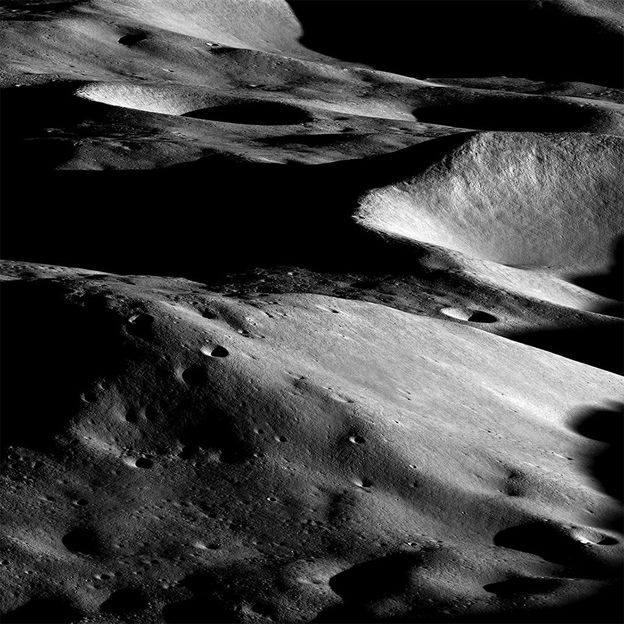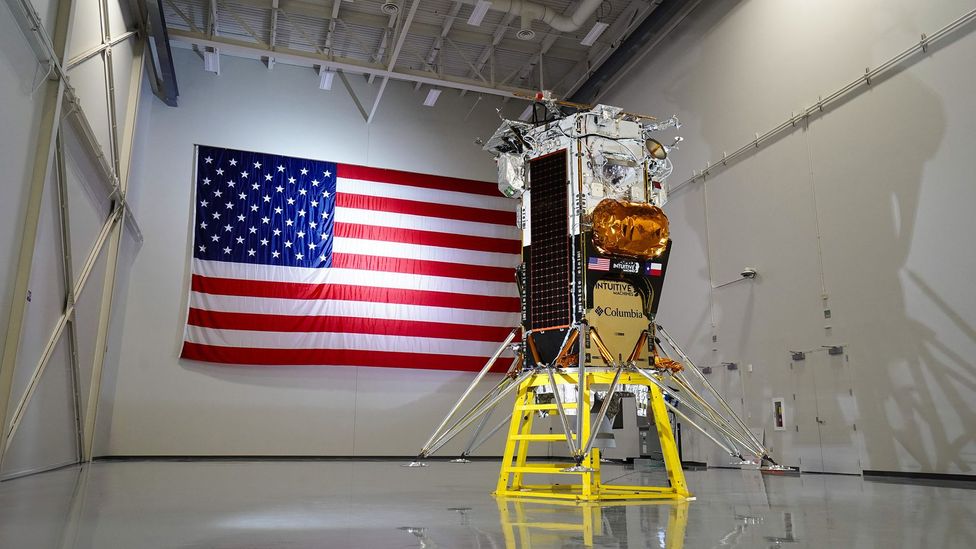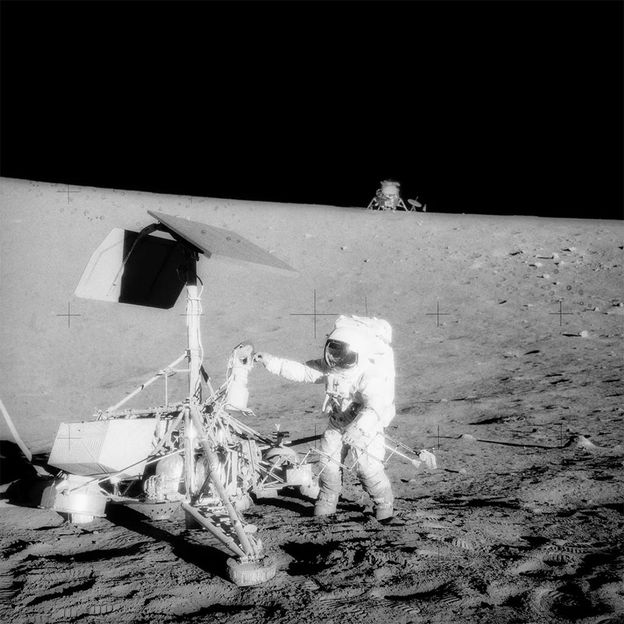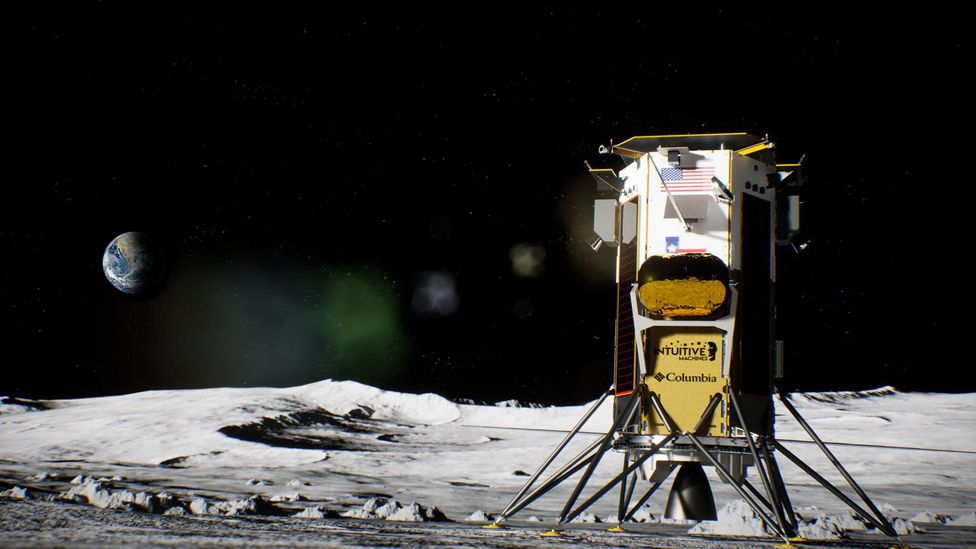Lunar exploration is heating up once more, and it is also changing. Intuitive Machines, a firm based in Houston, Texas, has become the first commercial company to successfully land on the Moon, near the lunar south pole.
The strikingly tall, hexagonal cylinder Nova-C lander, named Odysseus, launched on a SpaceX Falcon 9 rocket on 15 February and successfully entered lunar orbit on 21 February. It soft-landed in a crater known as Malapert A, in the region of the Moon's south pole at around 10:23pm GMT (18:23pm EST) on 22 February. (Read a report on the landing from the BBC's Science Correspondent Jonathan Amos and his live coverage as it happened.)
The mission is the first American lunar landing in more than 50 years, since the crewed Apollo 17 mission in December 1972. It's part of Nasa's Commercial Lunar Payload Services (CLPS) initiative intended to support the agency’s Artemis programme that is aiming to send astronauts back to the Moon and even build a permanent base there. Just 12 men have set foot on the Moon, so Artemis will also aim to land the first woman on the lunar surface. Sending robotic missions like Odysseus are essential steps torwards the next giant leap.
In January 2024, an earlier attempt to set the unmanned Peregrine mission from Astrobotic under the same initiative was unsuccessful.
But landing on the lunar surface is only the beginning for Odysseus. The lander will begin a suite of experiments that will hopefully provide data useful for a wave of future missions and help to ensure the safety of humans when they eventually return to set foot on the lunar regolith.
A set of four tiny cameras funded by Nasa are installed around the base of Odysseus. These cameras, or the Stereo Cameras for Lunar Plume-Surface Studies (Scalpss), are designed to collect still frame and video footage of the landing and how the exhaust plume from Odysseus's landing engines interact with the dusty lunar surface. Teams of scientists on Earth will use the data collected to build 3D models of the landing site, before and after landing, measuring how the landscape changes. While small, these instruments will help with the work needed to make sustained lunar exploration safe.

The lander will touch down on the Malapert-A crater near the Moon’s South Pole (Credit: Nasa)
While the Apollo missions provided a treasure trove of information and insights about the Moon, they also uncovered issues that still need to be answered before humanity returns.
When Apollo 12 landed on the Moon in November 1969, it set down within 200m (656ft) of an earlier visitor to our planet's celestial neighbour. Astronauts Pete Conrad and Alan Bean walked to Surveyor 3, a robotic lander that had been on the lunar surface for two and a half years, cut pieces off and brought them back to Earth. Resulting analysis revealed that the Apollo 12 landing had sandblasted Surveyor 3.
"The rocket exhaust itself is typically going about three or four kilometres per second (6,710-8,947mph)," says Phil Metzger, a former Nasa scientist who is now a planetary physicist at the University of Central Florida. "And the smallest particles will be accelerated up to that velocity… That's like five times the speed of a bullet."
With no atmosphere to stop it or slow it down, the dust and rocks blown off the Moon travel far and fast.
"It goes literally globally around the Moon and even blows completely off the Moon and can sandblast spacecraft that are in orbit," says Metzger.
It becomes a question of how much damage is acceptable – Phil Metzger
The US-led Artemis programme is intended to be more sustainable than the "flags and footprints" approach of earlier missions. Setting up an Artemis Base Camp on the Moon means making frequent precise landings – and launches from the lunar surface – in close proximity to each other. This will have to be done while keeping both hardware and astronauts safe.
Sandblasting your lunar setup thus becomes a big issue, and could impact landing site selection, the design of spacecraft and mission planning.
"It becomes a question of how much damage is acceptable," says Metzger. "If you have sensitive instruments, or if you have hardware that's going to be exposed to many sandblasting events, such as at a lunar outpost, where you'll be having spacecraft landing and departing frequently, then we need to manage the amount of damage."
Landing pads, berms, curtains or other structures could be used to block streams of accelerated lunar dust. The current mission may help designers work out what material they should be made of.

The lander’s technologies include cameras to capture how much moondust is blasted into space when the lander fires its rocket exhausts (Credit: Intuitive Machines)
It's an issue that will require international coordination and collaboration. China is leading its own group of countries for another lunar exploration project: the International Lunar Research Station (ILRS). One precursor mission, Chang'e-7, slated for 2026, aims to land near Shackleton crater at the lunar south pole, an area also under consideration for Nasa's crewed Artemis 3 landing. (Read more about why there's a rush to explore the Moon's enigmatic South Pole.)
Damaging another country's spacecraft when landing your own could cause problems – or even an international incident. Knowing how far away a mission should land from another, and agreeing on this internationally, would be an important step.
"That's where missions like this Intuitive Machines landing become very helpful, because we can get data that will enable us to solve the physics," Metzger says. "Then, once we have a better grasp of the science, that can inform policy decisions going forward."
Another instrument aboard Odysseus is a small laser retroreflector. Developed by Nasa, the tiny Laser Retroreflective Array (LRA) could once again play an outsized role in lunar exploration. An LRA is a passive aluminium hemisphere just 5cm (2in) in diameter weighing just 20g (0.7oz). On this hemisphere are eight fused silica glass retroreflectors designed to reflect light directly back to its source. A spacecraft shining a laser can thus bounce light off an LRA and measure the time taken to receive a pulse back to determine the distance between them.
Navigation and communications satellites will play a role in supporting Artemis operations on the Moon
"Lasing from Earth to specific points on the surface to identify their exact location can be part of the process of how we generate a precise model of where everything is on the Moon. This is needed to be able to navigate," says James Carpenter, the European Space Agency's (Esa) discipline lead for planetary sciences.
LRAs can act as markers to help orbiting satellites to establish navigation and positioning services similar to the Global Positioning System (GPS) that has become part of our everyday lives back on Earth. The more of these there are, the easier and quicker it is for a spacecraft to determine its position in orbit. Navigation and communications satellites will play a role in supporting Artemis operations on the Moon, allowing both coordination and and tracking of movement on the surface.

Surveyor 3 was inspected by astronauts from Apollo 12 and was found to have been “sandblasted” by dust kicked up by the lander touching down (Credit: Nasa)
Retroreflectors have been used before, on Apollo missions and a couple of Soviet-era Luna spacecraft. These have been targeted by powerful Earth-based lasers to make precise measurements of the distance between the Earth and Moon. (Find out how reflectors left by Apollo astronauts have revealed the Moon is drifting away from the Earth.)
"The current reflectors are located across a very limited range of latitudes and longitudes, which limits what we can measure. If we can extend the range of locations where these reflectors are located then it will give us much better measurements and we can look deeper," says Carpenter.
Nasa's Lunar Reconnaissance Orbiter successfully tested the new LRA recently by "pinging" India's Chandrayaan-3 lander.
You might also like:
- The other nations with the Moon in their sights
- The hunt for the trees sent to the Moon
- How Apollo changed the modern world
Having LRAs dotted around the Moon on landers such as Odysseus could also help spacecraft with range-finding and making precision landings needed to build up lunar infrastructure. It could also help spacecraft land in otherwise dark places, such as close to permanently shadowed regions, or patches where the Sun never shines near the lunar south pole, the region in which Odysseus aims to land.
Intuitive Machines' Odysseus is just one of a number of lunar missions this year alone. But if its mission is a success, it could help could help pave the way for more advanced, safe, and efficient Moon missions – and eventually a lunar settlement.
--
If you liked this story, sign up for The Essential List newsletter – a handpicked selection of features, videos and can't-miss news delivered to your inbox every Friday.
Join one million Future fans by liking us on Facebook, or follow us on Twitter or Instagram.
